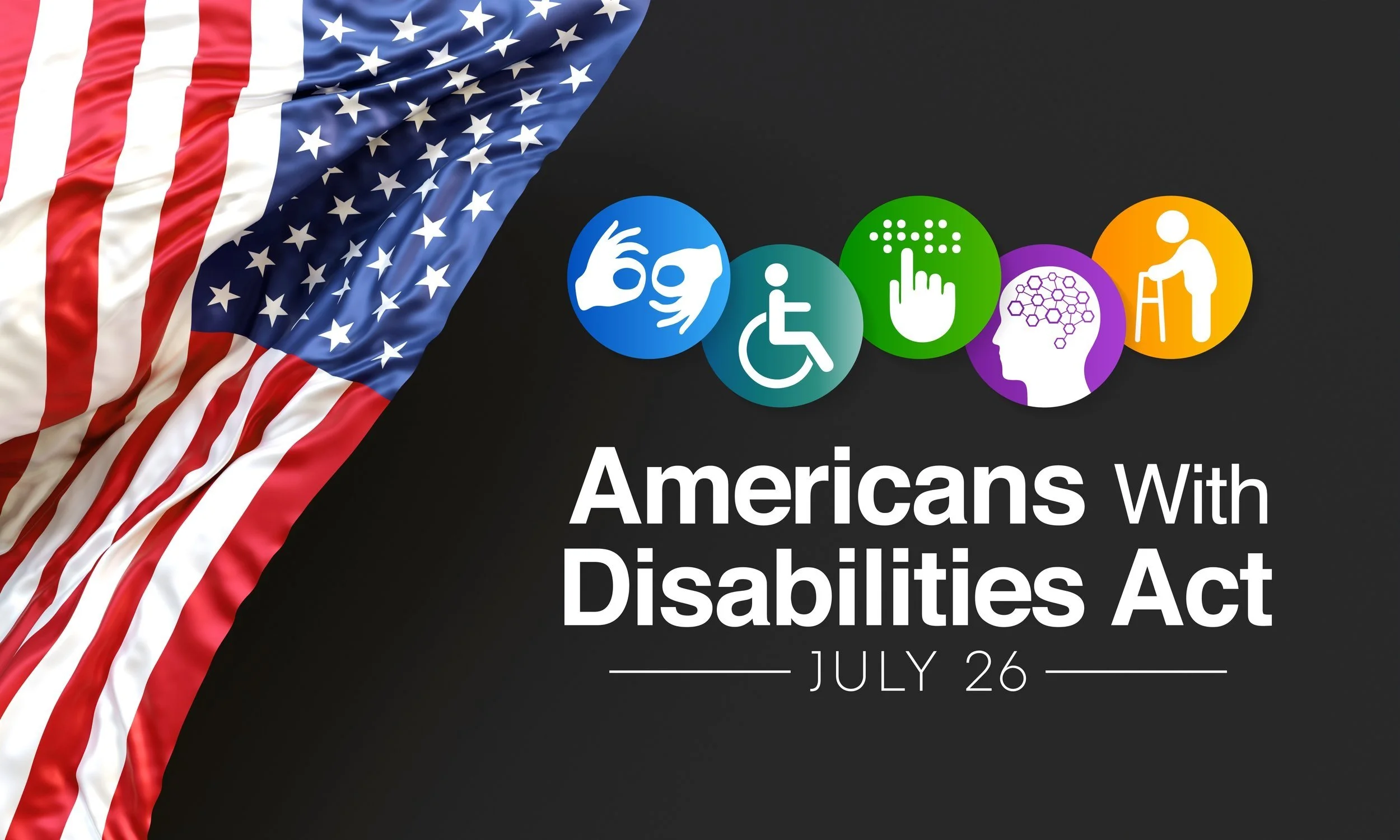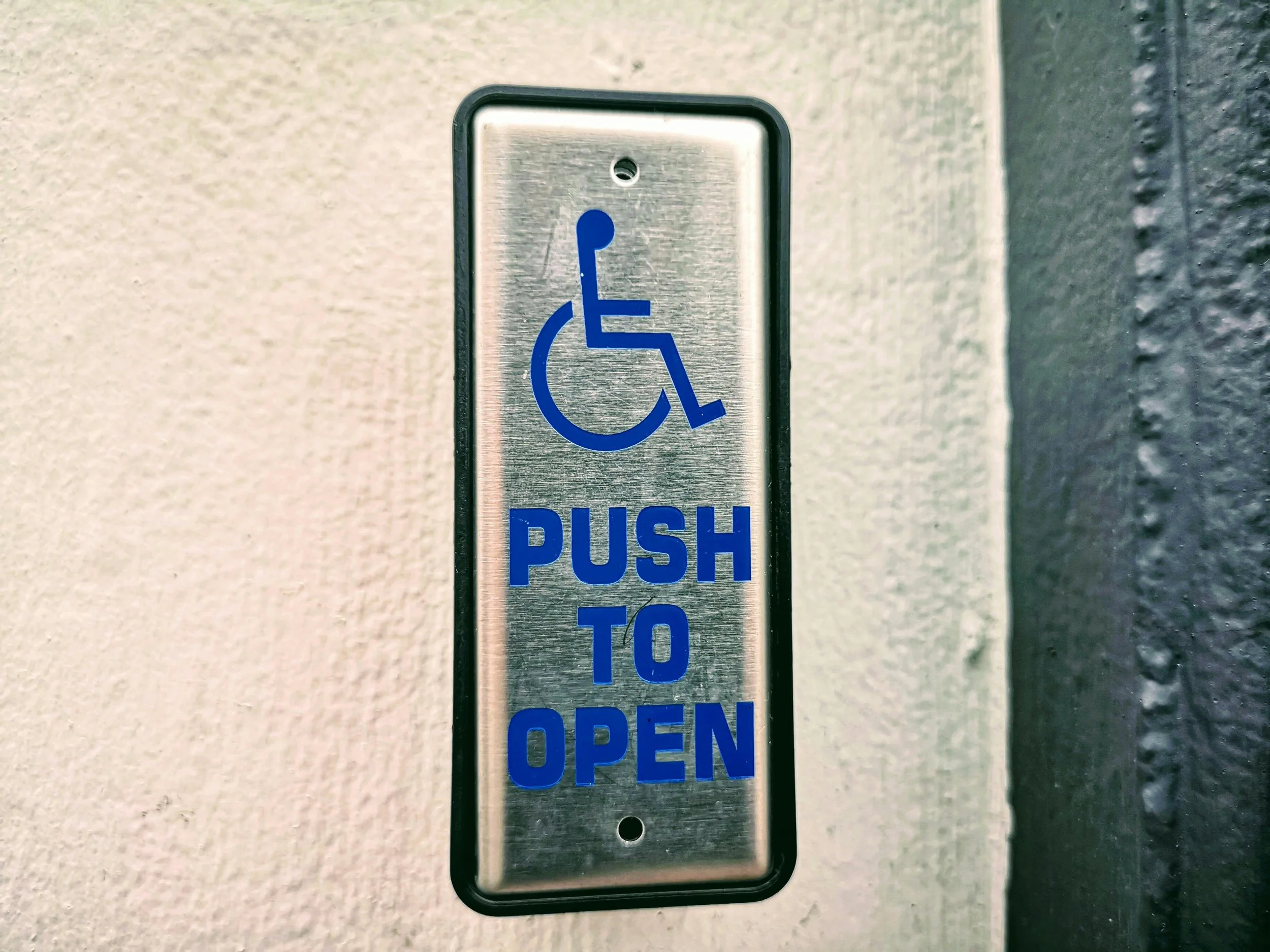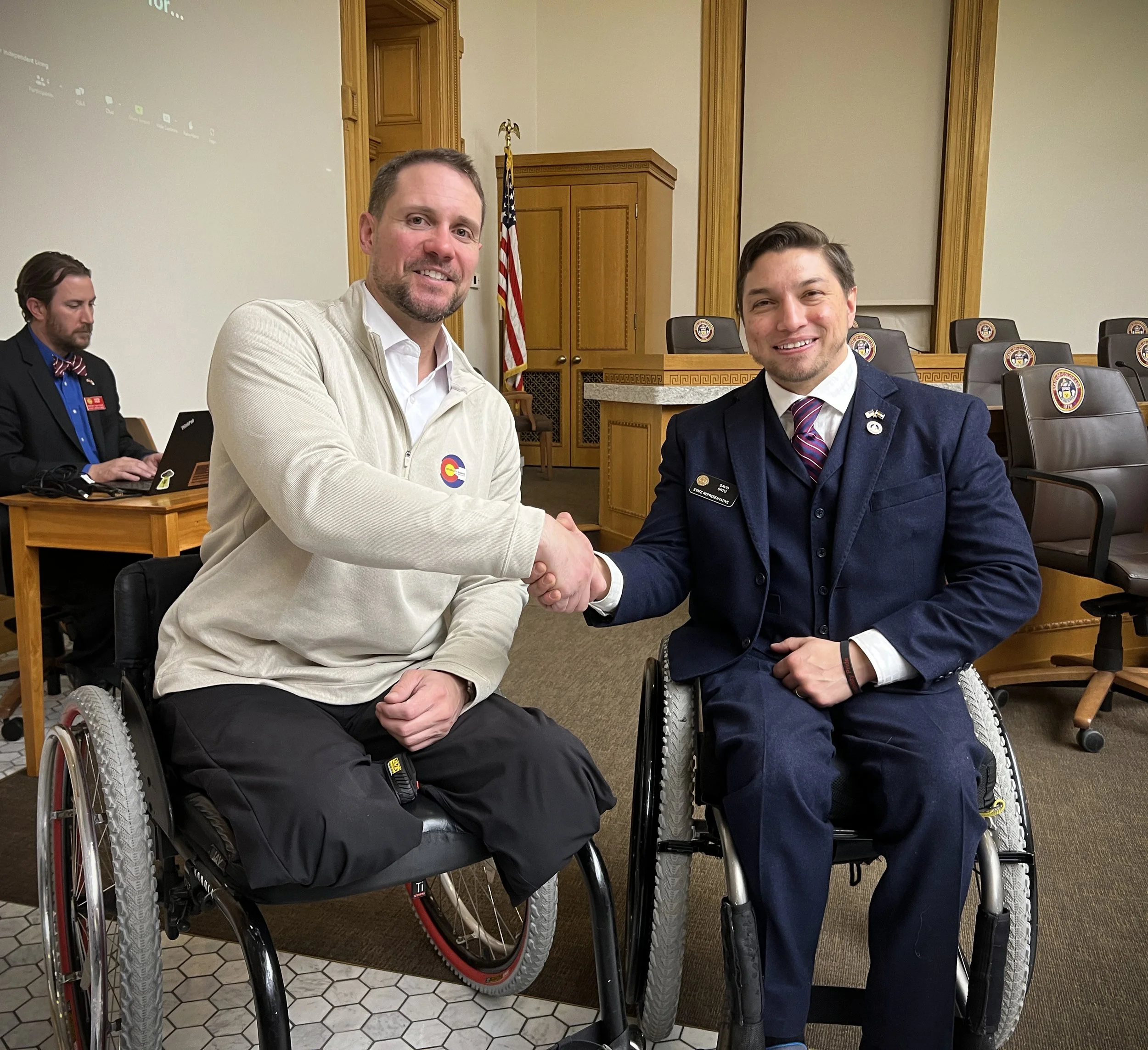Everyday Freedom: Celebrating the ADA in Our Lives Today
Image: A graphic with an American flag on the left. The text reads "Americans with Disabilities Act. July 26.
Every July, we celebrate the anniversary of the Americans with Disabilities Act (ADA). This civil rights milestone continues to shape our world in profound and often invisible ways. In this article, we will explore how everyday experiences we take as the norm were hard-won by advocates for the ADA, how the ADA shapes your life today, and what it would look like if the ADA had never come to pass.
The ADA was signed into law on July 26, 1990. It affirmed what disability advocates had long fought for: equal access, opportunity, and legal protection. It was a monumental step forward in transforming public spaces, reshaping policies, and opening doors (literally and figuratively) that had long been closed.
Today, more than 30 years later, the ADA is deeply woven into everyday life. So much so that many of its impacts go unnoticed by those who benefit from them every day. It’s easy to focus on what’s still needed, and important that we do. But it's also essential to pause and appreciate what has been achieved. When we take the time to celebrate our steps to a more inclusive society, we invite further growth, together.
Because of the ADA, millions of people with disabilities can participate equally in community life in ways that would have been nearly impossible a generation ago.
Because of the ADA…
Students with mobility devices use the same front doors as their peers
Without the ADA, many students would still be relegated to side doors, basement classrooms, or forced to sit out of field trips or events because buildings weren’t accessible.
Image: A button to press to automatically open doors for wheelchair access is pictured.
Take the story of Eleanor Smith, a polio survivor who attended school in the 1950s. In her oral history with UC Berkeley’s Regional Oral History Office, she describes how, after contracting polio at age three, she was hospitalized for a year and then returned home, but attended a school with no wheelchair access. She and her family had to arrange, and pay for, someone to carry her up and down the school’s steps each day.
In most schools today, automatic doors, ramps, and elevators are the norm. A student using a wheelchair enters school through the same entrance, attends class in an accessible room, and uses restrooms designed with their needs in mind.
The 2010 ADA Standards mandate that when schools undergo renovations, “any portion of the facility that can be made accessible shall be made accessible,” including restrooms, drinking fountains, routes, and entrances.
In higher education, disability services offices coordinate Universal Design and accommodations, like adjusted desks and accessible classrooms, enabling students with mobility devices to learn alongside peers.
Service animals are protected and welcomed
Without the ADA, service animals were often turned away at the door in public places, forcing people to sacrifice independence or access.
Image: A service dog sits outside in the forest, alert with attention.
Children like Ehlena Fry, whose service dog Wonder helped her navigate her school day, are now protected by law. A landmark Supreme Court decision in 2017, Fry v. Napoleon Community Schools saw 13-year-old Ehlena Fry win the right to bring her service dog, Wonder, to school. Wonder assisted her with everyday tasks like opening doors, picking up items, and helping her balance. And the Court confirmed that schools must modify policies and allow service animals under the rules of the ADA.
Job applicants can request accommodations without fear
Without the ADA, qualified people were denied jobs or quietly excluded due to inaccessible work environments or outdated biases.
The ADA requires employers to provide reasonable accommodations, like screen readers, ergonomic workstations, or flexible schedules. Job seekers can now ask for what they need to succeed without fear of discrimination.
As an example from askjan.org, a senior executive at a major corporation was diagnosed with Guillain-Barré Syndrome, which severely impacted his mobility and ability to commute. Rather than leave the company, he was provided with two key accommodations under ADA guidelines:
A work-from-home arrangement, allowing him to fulfill his role remotely.
Alternative input software to operate a computer with limited hand strength.
These relatively simple adjustments meant he could continue working effectively and keep his career on track, despite a serious medical challenge.
The Job Accommodation Network reports that over half of workplace accommodations cost nothing, and most improve productivity for the entire team in a workplace.
Public transportation is accessible and inclusive
Without the ADA, getting to work, school, or the grocery store still required relying on others, or being excluded from transit entirely.
Image: Protestors with disabilities, known as the “Gang of 19” gather around an RTD bus in Denver in 1978.
On July 5–6, 1978, a group of 19 disability rights activists, later known as the “Gang of 19,” took a stand in downtown Denver. They surrounded two buses at the busy Colfax Avenue and Broadway intersection with their wheelchairs, chanting “We will ride!” for nearly 24 hours. This protest demanded that the Regional Transportation District (RTD) retrofit buses with wheelchair lifts so riders with disabilities could use them independently.
The demonstration succeeded: RTD began retrofitting buses with lifts on key routes in 1978, completing the full fleet by 1982. When the first lift-equipped bus rolled out, an RTD operator, whose grandmother had been at the protest, proudly saw its first wheelchair user board, marking the start of a new era of inclusive transit in Denver.
In the decades that followed, these conversions spread nationwide and later became legally mandated by the ADA. Curbside lifts on buses, level boarding on trains, and talking stop announcements are now the norm. In cities like Denver, RTD buses all include securement zones and priority seating.
The ADA requires all fixed-route public transportation systems to be accessible, leading to a nationwide overhaul of buses, light rails, and transit hubs.
Emergency evacuation plans include everyone
Without the ADA, emergency procedures often ignored the needs of people with disabilities, leaving them at disproportionate risk.
In January 2013, the U.S. Department of Justice filed a complaint against New Rochelle High School in New York for violating Section 504 and the ADA. During fire drills before 2013, two students using mobility devices, identified as “J.F.” and “A.B.,” were consistently excluded from evacuation procedures. One aide would wait by the elevator for them to be escorted after the bell, and on other occasions, the students would remain on upper floors while the rest of the school evacuated. School staff lacked proper evacuation chair training, and elevators were shut off during drills, forcing reliance on inconsistent personal arrangements rather than inclusive planning.
Following DOJ intervention, New Rochelle High School was required to develop inclusive emergency plans that involved students with mobility needs in drill participation, and train all relevant staff, not just a few security guards, to operate evacuation chairs. They also had to ensure elevators stayed operational during drills for full evacuation participation.
Today, these are not just best practices, but are legal requirements under the ADA and NR 504. Schools and public buildings across the country now incorporate:
Visual and auditory alarms,
Accessible exit routes and evacuation chairs.
Staff training and clearly marked area-of-refuge zones for individuals who use mobility aids, all guided by NFPA’s ADA‑informed Emergency Evacuation Planning Guide.
Modern emergency planning must account for people with mobility, hearing, and cognitive disabilities. That means visual fire alarms, accessible exits, and trained staff who know how to assist everyone safely. The National Fire Protection Association provides ADA-compliant evacuation templates and training guides, now used in schools, offices, and hospitals across the country (NFPA).
Digital spaces are becoming more inclusive
Image: A blind woman listens to the screen reader on her phone.
The ADA’s influence now reaches into the digital world, which was not as common in everyday life in 1990 as it is today. Whether ordering groceries, registering to vote, or applying for a job, websites and apps must meet accessibility standards, which means supporting screen readers, keyboard navigation, and more.
Without the ADA, these important services would remain inaccessible, isolating people from healthcare, education, and civic participation.
In 2006, the National Federation of the Blind (NFB) sued Target Corporation in National Federation of the Blind v. Target Corp., arguing that Target’s website was inaccessible to people who are blind due to missing alt text, poor navigation, and lack of screen reader support. The U.S. District Court agreed, ruling that websites count as 'places of public accommodation' under the ADA, meaning they must be accessible to all users.
As a result of the case, Target updated its site to include meaningful alt text, improved keyboard navigation, and enhanced screen reader compatibility. In 2010, the NFB awarded Target’s site “Gold Standard” certification for non-visual accessibility.
Their settlement became a national benchmark, prompting scores of other retailers and service providers to improve accessibility, even before formal federal rules existed
In 2023, the DOJ proposed updated Title II rules requiring digital accessibility across state and local government services, paving the way for a more inclusive online world (ADA.gov).
Looking Forward: A Vision for the Future
The ADA laid the groundwork, but our work is not done. As we celebrate how far we’ve come, we also imagine what’s possible next. Here's what we envision, and what it could mean:
Universal Design becomes the standard
Designing with everyone in mind from the start, not retrofitting after the fact, becomes the new norm in architecture, products, and policy.
What this could look like is housing developments that include roll-in showers and wide doorways by default. Public parks with sensory-friendly trails and tactile maps. Classrooms where adjustable lighting and seating help all learners thrive.
Organizations like the Center for Inclusive Design and Environmental Access (IDEA Center) are already working with developers to create buildings that exceed basic accessibility by designing for dignity, not just compliance.
To learn more about Universal Design, read this previous article we published on the topic.
Digital inclusion is fully realized
All online spaces, from telehealth to entertainment to banking, meet or exceed Web Content Accessibility Guidelines (WCAG), ensuring every user can navigate, contribute, and belong.
What this could look like is websites with clear structure and alt text by default, accessible mobile apps, and real-time AI captioning for all live streams.
The World Wide Web Consortium (W3C) continues to evolve standards for truly inclusive digital access, and the ADA’s legal reach is helping enforce them.
Representation is everywhere
Image: Craig Towler, the Director of Public Policy & Advocacy for CPWD, shakes hands with Rep. David Ortiz. Both are wheelchair users.
People with disabilities are not just included, they are visible, empowered leaders. In boardrooms, city councils, classrooms, and media, authentic representation drives culture forward.
What this could look like is more elected officials with disabilities shaping policy. TV shows with characters played by actors who share their lived experience. Business leaders mentoring the next generation of innovators with disabilities.
Initiatives like the Disability Media Alliance Project are working to ensure authentic storytelling and representation in film and media.
Assistive technology is personalized, affordable, and mainstream
Tech isn’t just about accessibility, it’s about innovation. From smart prosthetics to adaptive gaming, tools evolve to empower independence, creativity, and full participation.
What this could look like is wearable AI that interprets environments, home automation that responds to voice or eye movement, and insurance coverage that puts these tools within reach.
Nonprofits like the Christopher & Dana Reeve Foundation and companies like Google are already shaping the future of inclusive tech. The Reeve Foundation funds innovations like wearable exoskeletons that help people with paralysis walk, smart home systems for greater independence, and adaptive gaming for connection and well-being. Meanwhile, Google’s Project Euphonia uses machine learning to improve speech recognition for people with atypical speech, making voice assistants and dictation tools more accessible. These advancements embody the ADA’s spirit by expanding independence, equity, and inclusion through technology.
Celebrating the ADA Means Living Its Promise
Through the consumers, staff, and board members, we see the impact of the ADA every day in the independence it supports, the opportunities it unlocks, and the dignity it protects. So today, we celebrate. We remember what came before, we acknowledge the progress made, and we recommit to the work still ahead. Because equity, access, and inclusion aren’t a destination, they’re a path we walk together.
Happy ADA Anniversary. Let’s keep moving forward.







